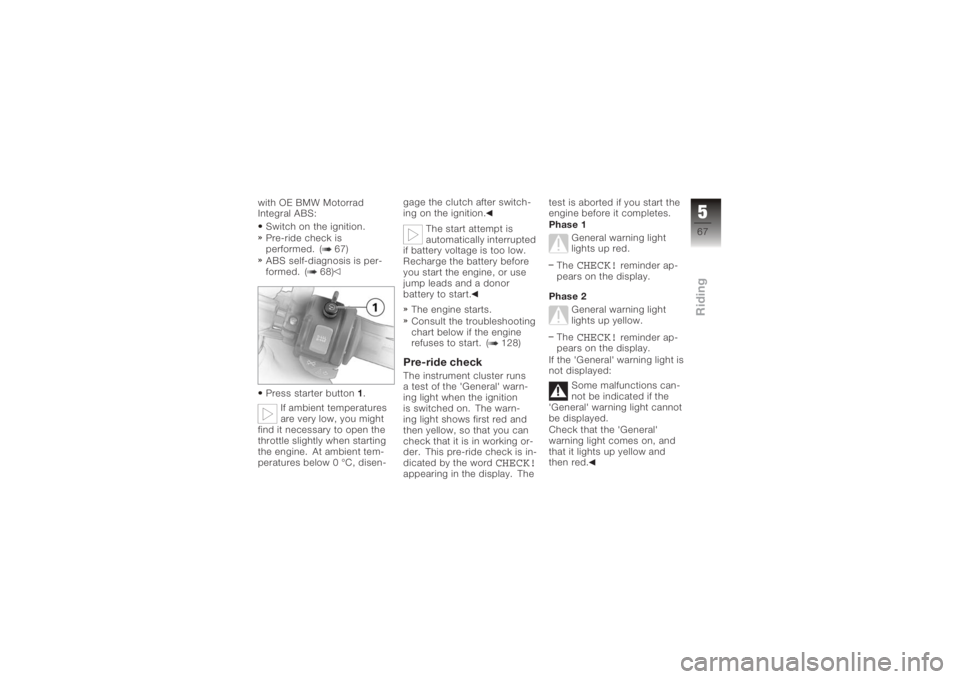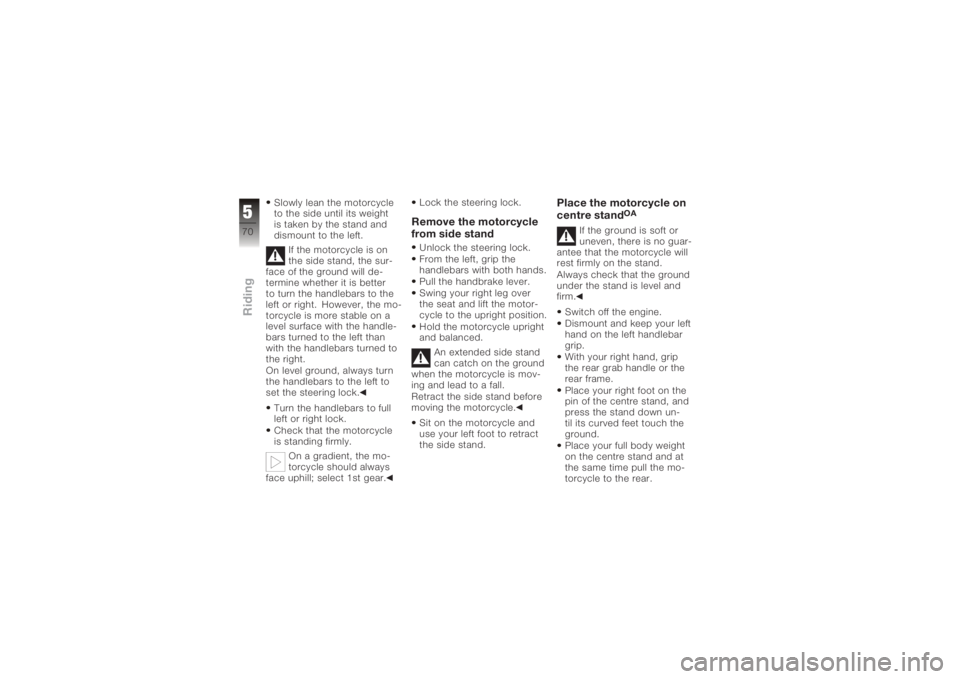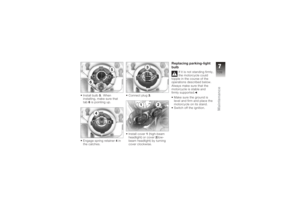Page 65 of 160
Riding
Safety instructions . . . . . . . . . . . . . 64
Checklist . . . . . . . . . . . . . . . . . . . . . . 66
Starting . . . . . . . . . . . . . . . . . . . . . . . 66
Running in . . . . . . . . . . . . . . . . . . . . 68
Parking your motorcycle . . . . . . . 69
Refuelling . . . . . . . . . . . . . . . . . . . . . 71
Tyre pressure control RDC
OE
.. 72
Brake system, general . . . . . . . . . 73
Brake system with BMW
Motorrad Integral ABS
OE
....... 74
563zRiding
Page 66 of 160

Safety instructionsRider's equipmentDo not ride without the cor-
rect clothing. Always wear:Helmet
Motorcycling jacket and
trousers
Gloves
Boots
This applies even to short
journeys, and to every sea-
son of the year. Your author-
ised BMW Motorrad dealer
will be glad to advise you on
the correct clothing for every
purpose.SpeedIf you ride at high speed, al-
ways bear in mind that vari-
ous boundary conditions can
adversely affect the handling
of your motorcycle: Settings of the spring-strut
and shock-absorber system
Imbalanced load
Loose clothing
Insufficient tyre pressure
Poor tyre tread
Etc.
Correct loading
Overloading and imbal-
anced loads can ad-
versely affect the motorcycle's
handling.
Do not exceed the permiss-
ible gross weight and be sure
to comply with the instruc-
tions on loading.
Alcohol and drugs
Even small amounts of
alcohol or drugs will ad-
versely affect your percep-
tion and your ability to as-
sess situations and make de-
cisions, and slow down your reflexes. Medication can ex-
acerbate these effects.
Do not ride your motorcycle
after consuming alcohol,
drugs and/or medication.
Risk of poisoningExhaust fumes contain car-
bon monoxide, which is col-
ourless and odourless but
highly toxic.
Inhaling the exhaust
fumes therefore
represents a health hazard
and can even cause loss
of consciousness with fatal
consequences.
Do not inhale exhaust fumes.
Do not run the engine in an
enclosed space.
564zRiding
Page 67 of 160

High voltage
Touching live parts of
the ignition system with
the engine running can cause
electric shock.
Do not touch parts of the igni-
tion system when the engine
is running.
Catalytic converterIf misfiring causes unburned
fuel to enter the catalytic con-
verter, there is a danger of
overheating and damage.
For this reason, observe the
following points:
Do not run the fuel tank dry.
Do not attempt to start or
run the engine with a spark-
plug cap disconnected.
Stop the engine immediately
if it misfires.
Use only unleaded fuel.
Comply with all specified
maintenance intervals. Unburned fuel will des-
troy the catalytic con-
verter.
Note the points listed for
protection of the catalytic
converter.
Risk of fireTemperatures at the exhaust
are high.
Flammable materials
(e.g. hay, leaves, grass,
clothing and luggage, etc.)
could ignite if allowed to
come into contact with the
hot exhaust pipe.
Do not permit flammable ma-
terials to come into contact
with the hot exhaust system.
Cooling would be
inadequate if the engine
were allowed to idle for
a lengthy period with the
motorcycle at a standstill:
overheating would result. In extreme cases, the
motorcycle could catch fire.
Do not allow the engine to
idle unnecessarily. Ride away
immediately after starting the
engine.
Tampering with the
control unit of the
electronic engine-
management system
Tampering with the con-
trol unit of the electronic
engine-management system
can damage the motorcycle
and cause accidents.
Do not tamper with the
control unit of the electronic
engine-management
system.
Tampering with the con-
trol unit of the electronic
engine-management system
can result in mechanical loads
that the motorcycle's com-
565zRiding
Page 68 of 160

ponents are not designed to
withstand. Damage caused in
this way is not covered by the
warranty.
Do not tamper with the
control unit of the electronic
engine-management
system.ChecklistUse the following checklist
to check important functions,
settings and wear limits be-
fore you ride off.Brakes
Brake-fluid levels, front and
rear
Clutch
Clutch fluid level
Shock absorber setting and
spring preload
Tyre-tread depth and tyre
pressures Cases correctly installed
and luggage secured
At regular intervals: Engine oil level (every refuel-
ling stop)
Brake-pad wear (every third
refuelling stop)
StartingSide standYou cannot start the motor-
cycle with the side stand ex-
tended and a gear engaged.
The engine will switch itself off
if you start it with the gearbox
in neutral and then engage a
gear before retracting the side
stand.GearboxYou can start the engine
when the gearbox is in neutral
or if you pull the clutch with
a gear engaged. Do not pull
the clutch until after you have switched on the ignition, as
otherwise the engine will
refuse to start. When the
gearbox is in neutral, the
green neutral telltale light is
on and the gear indicator
in the multifunction display
shows N.
Start the engineKill switch
1in run posi-
tion A.
Switch on the ignition.
Pre-ride check is
performed. ( 67)
566zRiding
Page 69 of 160

with OE BMW Motorrad
Integral ABS:Switch on the ignition.
Pre-ride check is
performed. ( 67)
ABS self-diagnosis is per-
formed. ( 68)
Press starter button 1.
If ambient temperatures
are very low, you might
find it necessary to open the
throttle slightly when starting
the engine. At ambient tem-
peratures below 0 °C, disen- gage the clutch after switch-
ing on the ignition.
The start attempt is
automatically interrupted
if battery voltage is too low.
Recharge the battery before
you start the engine, or use
jump leads and a donor
battery to start.
The engine starts.
Consult the troubleshooting
chart below if the engine
refuses to start. ( 128)
Pre-ride checkThe instrument cluster runs
a test of the 'General' warn-
ing light when the ignition
is switched on. The warn-
ing light shows first red and
then yellow, so that you can
check that it is in working or-
der. This pre-ride check is in-
dicated by the word
CHECK!
appearing in the display. The test is aborted if you start the
engine before it completes.
Phase 1
General warning light
lights up red.
The
CHECK!
reminder ap-
pears on the display.
Phase 2 General warning light
lights up yellow.
The
CHECK!
reminder ap-
pears on the display.
If the 'General' warning light is
not displayed:
Some malfunctions can-
not be indicated if the
'General' warning light cannot
be displayed.
Check that the 'General'
warning light comes on, and
that it lights up yellow and
then red.
567zRiding
Page 70 of 160

Have the fault rectified as
quickly as possible by a
specialist workshop, prefer-
ably an authorised BMW
Motorrad dealer.ABS self-diagnosis
OE
BMW Motorrad Integral ABS
performs self-diagnosis to en-
sure its operability. Self-dia-
gnosis is performed automat-
ically when you switch on the
ignition. The motorcycle has
to move forward at a speed
above 5 km/h for the wheel
sensors to be tested.
Phase 1Test of the diagnosis-com-
patible system components
with the motorcycle at a
standstill. ABS warning light
flashes. Possible national variant
of the ABS warning light.
Phase 2 Test of the wheel sensors
as the motorcycle pulls
away from rest. ABS warning light
flashes.
Possible national variant
of the ABS warning light.
ABS self-diagnosis
completed The ABS warning light goes
out.
If an indicator showing an
ABS fault appears when ABS
self-diagnosis completes: You can continue to ride.
Bear in mind that neither
the ABS function nor the
integral braking function is
available. Have the fault rectified as
quickly as possible by a
specialist workshop, prefer-
ably an authorised BMW
Motorrad dealer.
Running inThe first 1000 kmWhile running in the mo-
torcycle, vary the throttle
opening and engine-speed
range frequently.
Try to do most of your rid-
ing during this initial period
on twisting, fairly hilly roads,
avoiding high-speed main
roads and highways if pos-
sible.
Exceeding the specified
engine speeds while run-
ning in will lead to increased
engine wear.
Keep to the specified engine
speeds for running in.
568zRiding
Page 71 of 160

Do not exceed the rpm lim-
its recommended for run-
ning in.Running-in speeds
<7000 min
-1
No full-load acceleration.
Avoid low engine speeds at
full load.
Do not omit the first inspec-
tion after 500 - 1200 km.Brake padsNew brake pads must "bed
down" and therefore do not
achieve their optimum friction
levels during the first 500 km.
You can compensate for this
initial reduction in braking ef-
ficiency by exerting greater
pressure on the levers. New brake pads can ex-
tend stopping distance
by a significant margin. Apply the brakes in good
time.
TyresNew tyres have a smooth
surface. This must be
roughened by riding in a
restrained manner at various
heel angles until the tyres
are run in. This running in
procedure is essential if the
tyres are to achieve maximum
grip.
Tyres do not have their
full grip when new and
there is a risk of accidents at
extreme angles of heel.
Avoid extreme angles of
heel.
Parking your
motorcyclePlace the motorcycle on
side stand
If the ground is soft or
uneven, there is no guar-
antee that the motorcycle will
rest firmly on the stand.
Always check that the ground
under the stand is level and
firm.
Switch off the engine.
Pull the handbrake lever.
Hold the motorcycle upright
and balanced.
Use your left foot to extend
the side stand fully. The side stand is de-
signed to support only
the weight of the motorcycle.
Do not lean or sit on the mo-
torcycle with the side stand
extended.
569zRiding
Page 72 of 160

Slowly lean the motorcycle
to the side until its weight
is taken by the stand and
dismount to the left.If the motorcycle is on
the side stand, the sur-
face of the ground will de-
termine whether it is better
to turn the handlebars to the
left or right. However, the mo-
torcycle is more stable on a
level surface with the handle-
bars turned to the left than
with the handlebars turned to
the right.
On level ground, always turn
the handlebars to the left to
set the steering lock.
Turn the handlebars to full
left or right lock.
Check that the motorcycle
is standing firmly. On a gradient, the mo-
torcycle should always
face uphill; select 1st gear. Lock the steering lock.
Remove the motorcycle
from side standUnlock the steering lock.
From the left, grip the
handlebars with both hands.
Pull the handbrake lever.
Swing your right leg over
the seat and lift the motor-
cycle to the upright position.
Hold the motorcycle upright
and balanced.
An extended side stand
can catch on the ground
when the motorcycle is mov-
ing and lead to a fall.
Retract the side stand before
moving the motorcycle.
Sit on the motorcycle and
use your left foot to retract
the side stand.
Place the motorcycle on
centre stand
OA
If the ground is soft or
uneven, there is no guar-
antee that the motorcycle will
rest firmly on the stand.
Always check that the ground
under the stand is level and
firm.
Switch off the engine.
Dismount and keep your left
hand on the left handlebar
grip.
With your right hand, grip
the rear grab handle or the
rear frame.
Place your right foot on the
pin of the centre stand, and
press the stand down un-
til its curved feet touch the
ground.
Place your full body weight
on the centre stand and at
the same time pull the mo-
torcycle to the rear.
570zRiding
 1
1 2
2 3
3 4
4 5
5 6
6 7
7 8
8 9
9 10
10 11
11 12
12 13
13 14
14 15
15 16
16 17
17 18
18 19
19 20
20 21
21 22
22 23
23 24
24 25
25 26
26 27
27 28
28 29
29 30
30 31
31 32
32 33
33 34
34 35
35 36
36 37
37 38
38 39
39 40
40 41
41 42
42 43
43 44
44 45
45 46
46 47
47 48
48 49
49 50
50 51
51 52
52 53
53 54
54 55
55 56
56 57
57 58
58 59
59 60
60 61
61 62
62 63
63 64
64 65
65 66
66 67
67 68
68 69
69 70
70 71
71 72
72 73
73 74
74 75
75 76
76 77
77 78
78 79
79 80
80 81
81 82
82 83
83 84
84 85
85 86
86 87
87 88
88 89
89 90
90 91
91 92
92 93
93 94
94 95
95 96
96 97
97 98
98 99
99 100
100 101
101 102
102 103
103 104
104 105
105 106
106 107
107 108
108 109
109 110
110 111
111 112
112 113
113 114
114 115
115 116
116 117
117 118
118 119
119 120
120 121
121 122
122 123
123 124
124 125
125 126
126 127
127 128
128 129
129 130
130 131
131 132
132 133
133 134
134 135
135 136
136 137
137 138
138 139
139 140
140 141
141 142
142 143
143 144
144 145
145 146
146 147
147 148
148 149
149 150
150 151
151 152
152 153
153 154
154 155
155 156
156 157
157 158
158 159
159






